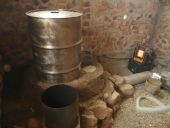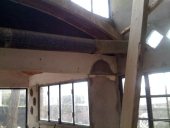
 1
1












"We're all just walking each other home." -Ram Dass
"Be a lamp, or a lifeboat, or a ladder."-Rumi
"It's all one song!" -Neil Young
 3
3




 1
1












Freakin' hippies and Squares, since 1986
 2
2












Judith Browning wrote:We have heated with wood for forty years...in three different homes with three different stoves and three different stovepipe setups. The earliest eventually setting the shake shingle roof on fire...our fault...too much creasote build up. The next was a bad barrel stove but the pipe went in to the old fireplace chimney and worked OK. Now we have an excellent stove...not quite large enough to heat more than two rooms in super cold weather but good enough...the pipe goes into a tile lined poured cement chimney and up 30 feet...it is a two story house. We burn mostly standing dead oak...white, red and post,some hickory and a few others that we cut on our forty acres. Tops from my husbands woodworking trees and shiitake log tree leftovers get used also This stove draws well and our luxury is the glass front door for viewing the flames from a well placed sofa.




 We also cook on our wood stove six months out of the year....and it simmers my natural dye pots...dries our clothes...warms my seed flats....keeps the muscadine wine at the right temperature.....
We also cook on our wood stove six months out of the year....and it simmers my natural dye pots...dries our clothes...warms my seed flats....keeps the muscadine wine at the right temperature.....
"We're all just walking each other home." -Ram Dass
"Be a lamp, or a lifeboat, or a ladder."-Rumi
"It's all one song!" -Neil Young
 1
1




 2
2




“Uncertainty is an uncomfortable position. But certainty is an absurd one.”
― Voltaire




 1
1




Jeremiah wales wrote:Great comments. This brings up another question.Outside chimneys vs inside chimneys. ( thru the center of the house.
My home had an inside chimney years ago. But it was removed just before I bought the place. A friend said. Just put a chimney on the outside wall. Its EZ. But I wonder how well it would work. Vs just my stove pipe.
 1
1








“Uncertainty is an uncomfortable position. But certainty is an absurd one.”
― Voltaire
 1
1












 2
2




Jeremiah wales wrote:So the Mass Crew talks about Horzontal Pipes for long distances in the mass and the Wood Stove Crew talks about No Horizontal Pipes.




























Vincent Parkhurst wrote:Quick, and maybe stupid, question! I have a wood stove with a 6" stove pipe. Am I able to connect that with an 8" chimney? I found a complete 8" chimney that will save me hundreds of dollars if so!
Vincent
 2
2




Jeremiah wales wrote:Let me throw this example out there.
You put a wood stove in the middle of your Basement. You run the exhaust pipe up 36" from the stove, then a 90 degree elbow, and horizontal aprox 12 feet to another 90 degree elbow to the outside wall of your structure to a Verticle pipe that runs 15 feet up as a chimney. Would this work properly.
Compare that to an insulated pipe outside.




Vincent Parkhurst wrote:Quick, and maybe stupid, question! I have a wood stove with a 6" stove pipe. Am I able to connect that with an 8" chimney? I found a complete 8" chimney that will save me hundreds of dollars if so!
Vincent
 1
1




Jeremiah wales wrote:
Compare that to an insulated pipe outside.


 1
1




Greg Mamishian wrote:
Jeremiah wales wrote:
Compare that to an insulated pipe outside.
Our approach is to use 20 feet of uninsulated stainless steel pipe inside...


...so that it can radiate heat into the house all the way up.




 2
2








 1
1




 1
1





|
Hoo hoo hoo! Looks like we got a live one! Here, wave this tiny ad at it:
Learn Permaculture through a little hard work
https://wheaton-labs.com/bootcamp
|



